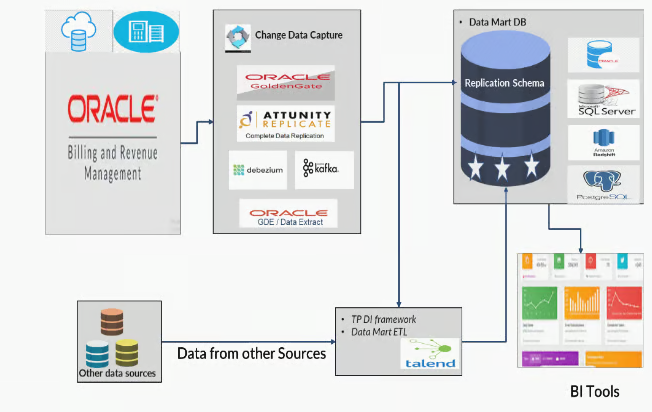Architecture and data flow
Overview
RIA Data Analytics is a comprehensive system designed to manage and execute data analytics and reporting tasks through its several key components.

Replica database
The Replica Database receives data from the Pricing and Billing system. Data replication tools capture changes from the source system and apply them to the Replica Database.
ETL framework
The ETL framework transforms raw data from the Replica Database into a Star Schema format using Talend ETL jobs. It integrates data from other organizational sources and loads the transformed data into a Datamart.
Datamart
The Datamart organizes data into Facts and Dimension tables. It also contains prebuilt Subject Areas such as Trial Bill, Accrual, Bill, Bill Calculation Line, Pricing, Payment Tender, Payment, Adjustment, Financial Transaction, General Ledger, To Do, Exception, Billable Charge, and Deal Management. Data is further processed into summary tables and views for reporting. These tables and views connect to reporting portals.
Security and user management
This component ensures robust security by allowing field and column-level security based on user roles. It guarantees that users have access only to the data they are authorized to view, enhancing data privacy and security.
Out-of-box reports and dashboards
RIA Data Analytics comes with a variety of prebuilt reports and dashboards that cover common organizational functions and data points. These are built using tools such as QlikView, BI Publisher, and Cognos, and are ready for immediate use post-implementation.
Dimensions and lookup tables
The architecture includes:
- SCD Type-2 Dimensions — These track historical data changes and include entities like Customer, Division, Account, Contract, Distribution Type, Adjustment Type, Price Assign, Price List Assign, To Do Type, Tender Source, Tender Type.
- SCD Type-1 Dimensions — These overwrite data with new updates and include entities like Cycle Schedule, Tender Control, Price Item, Policy, Reason, Message, Price Rule.
- Lookup Tables — These include Description Lookup, Currency Exchange, User Access Group.